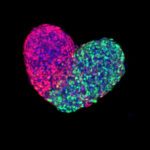Link to Pubmed [PMID] – 36897970
Link to DOI – 10.1073/pnas.2206163120
Proc Natl Acad Sci U S A 2023 Mar; 120(11): e2206163120
How collectives remain coordinated as they grow in size is a fundamental challenge affecting systems ranging from biofilms to governments. This challenge is particularly apparent in multicellular organisms, where coordination among a vast number of cells is vital for coherent animal behavior. However, the earliest multicellular organisms were decentralized, with indeterminate sizes and morphologies, as exemplified by Trichoplax adhaerens, arguably the earliest-diverged and simplest motile animal. We investigated coordination among cells in T. adhaerens by observing the degree of collective order in locomotion across animals of differing sizes and found that larger individuals exhibit increasingly disordered locomotion. We reproduced this effect of size on order through a simulation model of active elastic cellular sheets and demonstrate that this relationship is best recapitulated across all body sizes when the simulation parameters are tuned to a critical point in the parameter space. We quantify the trade-off between increasing size and coordination in a multicellular animal with a decentralized anatomy that shows evidence of criticality and hypothesize as to the implications of this on the evolution hierarchical structures such as nervous systems in larger organisms.

